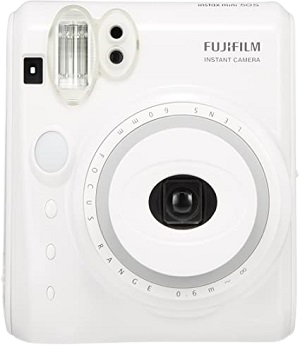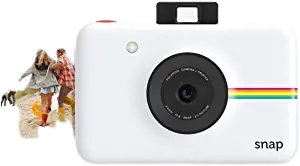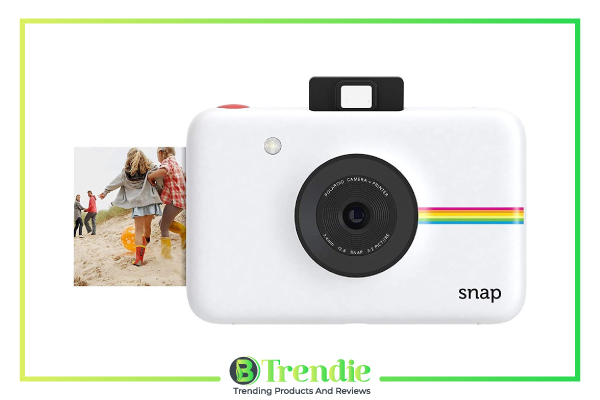A Quick Guide to Buying the Best Instant Film Camera
Instant print cameras are fun in a box. It’s the only camera that prints photos within minutes after taking them, and it does this without the help of a third-party printer. Take that, portable photo printers! But that’s just one of the reasons why we love a good ol’ ‘Polaroid’ as some people would call it, or why it continues to exist side-by-side with modern innovations in photography.
In between the photo developing slowly in front of you, that washed-out look you get on printed images, those colored filters and extra lenses that no digital photo filter (not even Instagram) could beat, and the analog charm of an instant print camera, there’s simply no replacing it.
Polaroid was first to invent these self-developing cameras, and for a time it was the only company that made them. As the years went by, camera makers like Fujifilm, Kodak, and Lomography started releasing their own versions of instant film cameras, giving us more options to choose from. But what does it take for an instant print camera to be considered a good bargain or a great choice? Now that there are dozens in line, how do you choose?
Tips for Choosing an Instant Film Camera
You don’t buy an instant print camera for its ability to capture true-to-life stills, autofocus system, image file formatting, and all those complex specs and features you’d have to consider with a digital camera. Rather, it’s a camera you happily take home with you because it gives you that warm fuzzy feeling each time you hit the shutter button and watch the magic unfold. Instant print cameras are much simpler in how they work. Too simple in fact, that it seems impossible to decide which one you should buy.
Not all of them are created equal, however. Underneath their toy-like appearance and basic functionality, these point-and-shoot cameras are exactly what they are – cameras. And much like any camera, they still have specifications, features, and designs which set them apart from one another. By considering these factors, you could make a wiser decision in choosing an instant print camera that doesn’t just make you happy the day you take it home. You get to have the best instant print camera which would add color to your life, one filter at a time.
| Image | Product | Features | Price |
|
Our Pick

|
Fujifilm Instax Mini 50S |
3.8 x 1.9 x 4.4 in |
|

|
Zink Polaroid Snap |
0.98 x 4.72 x 2.95 i |
|

|
Lomography Lomo'Instant Wide |
16.9 x 13.4 x 7.7 in |
Things to Consider: Buying an Instant Print Camera
1. Build and Design
Aesthetic appeal, ease of use, and portability are three things you should consider when assessing the design and quality of a particular model. Instant print cameras were never built for rugged use – at least, not in the same way other types of cameras are. So you should never make durability a deciding factor when making a purchase.
A compact and lightweight camera is perfect for anyone who plans to tag it along frequently, though you have to be careful when opting for a travel-friendly Polaroid. This could take a toll on its aesthetic value that you end up buying a camera that looks and feels cheap. It’s not something you would like if the design was a major concern. Ergonomics must be given equal importance. A simple design doesn’t always mean it’s easy to use. An instant print camera should have access controls, user-friendly features, and straightforward functionality which make it a delight to use.
2. Aesthetics
When choosing a camera based on its aesthetics, your personal preference matters most. Do you want a stunning vintage from Lomo? Maybe you would rather have a digital Polaroid? What about a modern-looking but secretly analog Instax? These are the questions you should ask yourself while deciding.
These specialty cameras may not be shockproof, waterproof, or dustproof like rugged cameras. They might even require special care to prolong their lifespan. Be that as it may, you should expect some degree of toughness from them. An instant film camera must be able to survive low-height falls and a few bumps without suffering from serious damage that would affect its use or function. To expect any less would be a waste of money.
3. Specifications and Features
The combined specifications and features of a camera help determine its general functionality and the quality of its images. We’ll spare you all the technical details and break them down to the instant camera specs that matter most.
4. Lens Type
A retractable lens is a superior choice. In spite of its tendency to attract dust, it’s nothing a good cleaning can solve. Compared to the non-retractable lens, a retractable option captures more light and allows for brighter images.
Tip: Try not to accidentally switch on the camera when inside tight spaces such as bags. It might jam the retracting lens and cause it to get stuck.
5. Lens Aperture
Also called the f-stop or f-number, it controls the area through which light enters the camera. Lower f-stop values mean larger apertures and a greater capacity for light. Thus, a camera with low f-stops is more capable of producing bright photos. Within the large aperture range are f/1.4, f/2, f/2.8, f/4, f/5.6, and f/8. Meanwhile, higher f-stop values equate to lower apertures and lesser capacity for light. A camera with high f-stops, therefore, produces darker images. A range of f/11, f/16, and f/22 are considered low aperture.
The lens aperture is likewise responsible for controlling a camera’s depth of field. A large aperture lens creates shallow depth-of-field. This is ideal for taking pictures within short distances since it brings subjects to view and blurs the background. A small aperture lens creates a full depth of field. This is a good choice for taking pictures of sceneries.
6. ISO and Shutter Speed
The ISO speed defines the exposure control or sensitivity of a camera’s sensor to incoming light. Low ISO speeds within the range of 50 to 800 are usually better since they are less likely to cause image noise or film grains in photos, even though they tend to be darker. High ISO speeds that are over 800 produce brighter pictures at the expense of visible noise, therefore reducing image quality.
The shutter speed tells you the duration in which light is allowed to enter the camera. A slow shutter speed brings in more light but increases the chances of blurring. If the subject moves or if you have shaky hands, you will likely get a fuzzy photo if the shutter speed is too slow. A fast shutter speed doesn’t allow for much light but it minimizes blurring caused by camera shakes and moving subjects.
Tip: ISO and shutter speed work together. As you go higher the ISO settings, you also get faster shutter speeds. ISO 800 sets an excellent middle ground for both light exposure and shutter speed. Under this setting, an instant print camera is able to produce sharp images with minimal noise and less blurring.
7. Exposure Compensation
Lighten/darken controls are extremely useful. The plus (+) and minus (-) settings let you increase or decrease the exposure at will so you can have brighter or darker photos. Compact cameras with a wide range of exposure compensation are suited for different environments and lighting conditions.
8. Flash Type
Always choose a self-developing camera with a flash. It produces artificial light for a brief moment in order to compensate for the lack of light. Captured subjects then appear brighter in printed photos. To get the best image quality, you need to be mindful of the type of flash built into the camera.
Instant print cameras either have built-in or pop-up flash. A built-in flash is embedded into the camera body and is usually located close to the lens. A pop-up type, even if it’s attached to the body, is situated further from the lens and pops open to reveal the flash – automatically after switching the camera on, or manually with the click of a button.
Photos may develop harsh contrasts with both types of flash, resulting in excessively bright subjects and very dark backgrounds. But this can be avoided with practice and knowing when to use the flash. Between the two flash types, a pop-up flash is less likely to create this unwanted result. It also requires less adjustment and is better suited for beginners who are inexperienced with instant film cameras.
9. Flash Mode
The flash could also be automated or manual. An automatic flash system, also known as “auto flash,” instantly calibrates the amount of artificial light it emits. This automatic calibration depends on the brightness of the environment. A manual flash system or “manual flash” emits a certain amount of light based on your chosen camera settings.
Most instant cameras have auto flash. They’re easier to use, though they tend to print photos with inconsistent levels of brightness. Those with manual flash give you better control over image brightness but require more experience.
Tip: The best models let you switch between auto and manual flash. It would also be ideal to choose an instant film camera with a flash switch, so you could turn it on and off any time you like. That way, you could decide whether or not you would use the flash when taking pictures.
10. Battery
Instant print cameras either come with generic batteries or rechargeable batteries. When choosing between the two, it all comes down to personal preference. Generic batteries such as AA and CR2 are cheap and widely available in stores but need to be replaced often. Rechargeable batteries tend to be proprietary, limiting their availability to a specific manufacturer or camera model. Rechargeable batteries are more expensive, but they are long-term investments that wouldn’t need replacing for some time.
Tip: Regardless of battery type, buy an instant print camera with an accessible battery compartment for quick changing.
11. Film
A good instant camera has a decent selection of compatible instant films. You should be able to choose from standard films (those with white borders), and films with printed or colored borders. Pre-designed instant films are a great way to add fun to your photographs, but standard films are timeless options fit for any occasion.
The film capacity of a camera is another factor to consider. Some models are able to carry more instant films than others, thus requiring fewer refills. Instant print cameras with a film capacity of 20 or higher offer more convenience, but they’re not really necessary.
Tip: You may want to purchase a model with an exposure counter. Also known as a film counter, it gives you the number of unexposed films left inside the camera.
12. Picture Size
Basically, an instant film camera may print portrait-sized or wide-format photos. Each camera prints slightly different variations of the two if measured to the last millimeter, but the differences are too minimal to be noticed. Cameras that print wallet-sized photos are better for taking portraits and close-ups. On the contrary, models that print wide-format photos are ideal for capturing sceneries, landscapes, and large groups of people.
13. Viewfinder
A viewfinder should display clear, unobstructed, and accurate views of the subject in focus. The resulting printed photo should be close to, or exactly the same as the view depicted on the viewfinder – neither too close nor too far.
14. Focus
The focusing ability of instant film cameras depends on their lenses. Built-in lenses usually focus within a limited but decent range. Cameras with options for adaptable lenses provide an extensive range of focusing modes including close-up, macro, fish-eye, and wide-angle.
15. Price
Instant film cameras are generally affordable, with prices ranging from $100 to $200. The more expensive models usually have digital features (i.e. LCD screen), which most people could do away with but others might be willing to spend on. The top instant film cameras balance price with design and function, giving you the most value for your hard-earned cash.
The Best Instant Print Cameras
1. Fujifilm Instax Mini 50S

Best Instax Camera of 2022
The Instax Mini 50S is one of the best instant film cameras for instant photography. It combines a compact modern design with ample features and a low price of $90. For a cheap camera, you’d be surprised by how well it works. Fujifilm Mini 50S prints great portrait-sized photos with accurate colors.
2. Zink Polariod Snap+

Best Polaroid Camera of 2022
Polaroid upgrades the Snap with a better-featured digital instant print camera – Snap Plus. It doesn’t look any different at first glance, but only because it has the same design as its predecessor. A closer look will reveal an improved 13MP CMOS sensor, a larger 3.5-inch touchscreen, and a new flash. Other additional features include 1080p HD video recording and the option to print photos on a compatible Bluetooth printer.
3. Lomography Lomo’Instant Wide

Best Lomo Camera of 2022
It prints photos on Fujifilm’s stock-wide format film but with some extra perks. For starters, it has a retro-style design typical of a Lomo. It produces incredibly artistic images which the Instax Wide 300 couldn’t match. Lomo’Instant Wide also adds a shutter remote feature on top of the three shooting modes originally found in Lomo’Instant.
Lomography Lomo’Instant Wide has the same f/8 aperture as its portrait-printing counterpart, resulting in brighter images than Fujifilm Mini 90 Neo. Lomography sells this camera for $200 and an extra $40 would get you additional lenses and filters.
4. Fujifilm Instax Mini 8+

Best Instant Print Camera of 2022
It’s cheap simple and tiny enough that it fits in most bags. It’s simple and uncomplicated – perfect for beginners. You just load in your film (fuji Instax mini film) point and shoot. No muss no fuzz. It features an automatic light sensor that tells you which settings (there are four of them) to use. This makes sure that you don’t have underdeveloped or overdeveloped images. It doesn’t have as many accessories as other instant print cameras but that makes it cheaper.





